Contents
Guide

INTRODUCTION
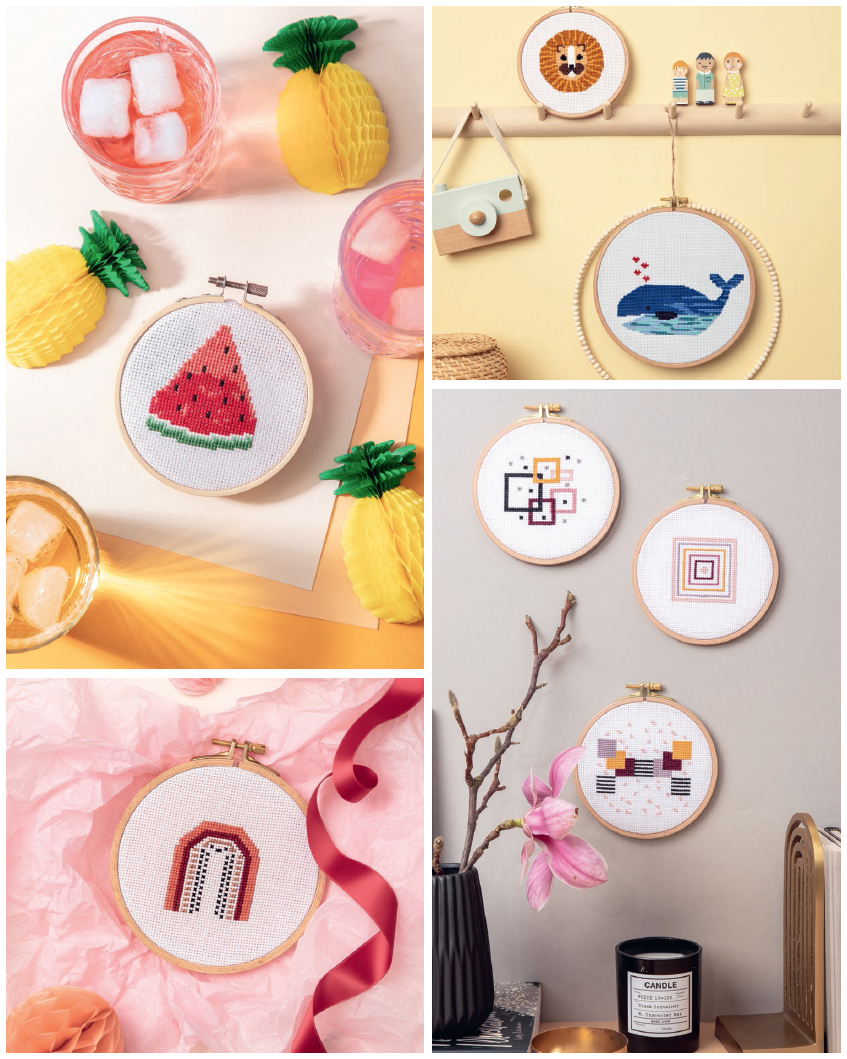
This book is for anyone who wants to get creative with stitching. Beginners will find valuable tips and instructions on all things embroidery, while those who are more advanced will find a colorful collection of creative and modern ideas that can all be completed with a single embroidery techniquethe cross-stitch. I designed this book to encourage you to use your imagination. The patterns can be mixed together to create unique individual pieces by using the embroidery alphabet to make various sayings and names. In addition, motifs have been designed in the same or similar color families so they can be easily combined. You can always start with one design and then go a step further by adding another motif from this series.
For me, it was also important that you could embroider several motifs even with a small color palettegreat for beginners! The different themes range from flowers to sayings to geometric animals. Theres really something for every taste and occasion, whether you intend to keep your finished piece or give it to someone else. My goal was to create a DIY book full of modern cross-stitch art, joy, inspiration, and super easy instructions to prove that this traditional craft is definitely not outdated. This book gives a simple and inspiring introduction to a hobby that requires only four items: a needle, thread, embroidery hoop, and fabric. Its time to get creative! Have fun with your cross-stitch and enjoy a little relaxation!  from Sonntagskreativitt (Sunday Creativity) THE BASICS
from Sonntagskreativitt (Sunday Creativity) THE BASICS 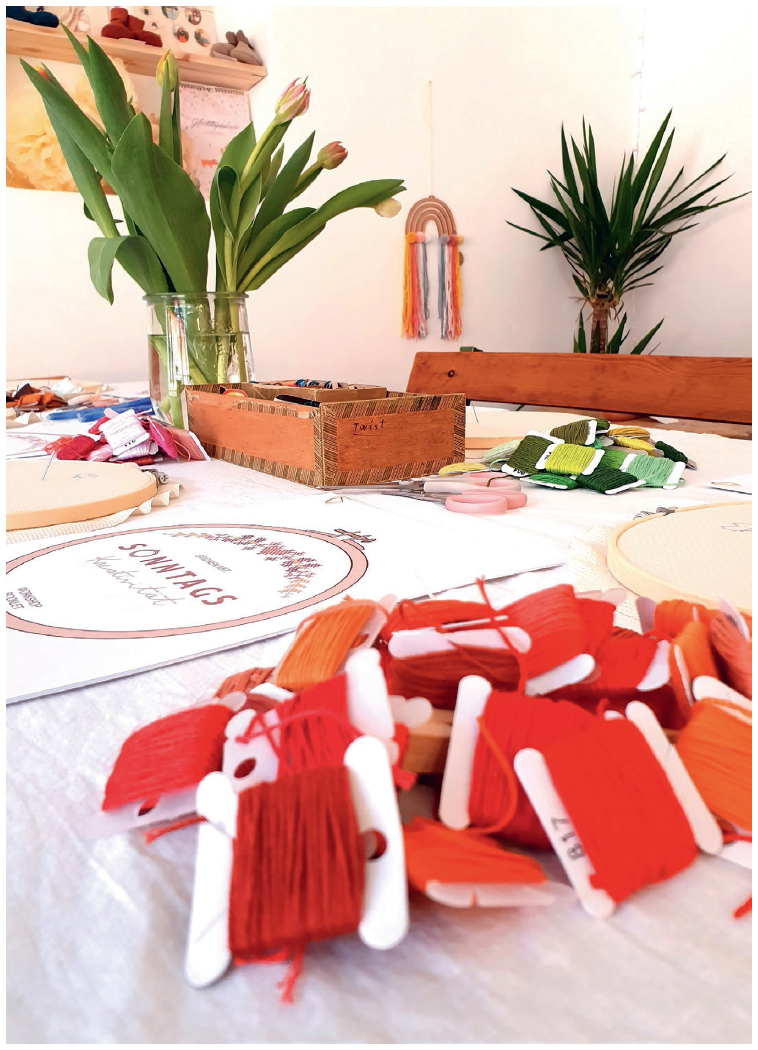 MATERIALS & EQUIPMENT Embroidery Floss Embroidery floss is available in different varieties and colors. Embroidery Floss (1) Embroidery floss is made up of 6 intertwined threads and is probably the most commonly used of all embroidery floss.
MATERIALS & EQUIPMENT Embroidery Floss Embroidery floss is available in different varieties and colors. Embroidery Floss (1) Embroidery floss is made up of 6 intertwined threads and is probably the most commonly used of all embroidery floss.
The shiny threads are excellent for embroidery projects. Embroidery floss comes in skeins of 8m (8yds) each with an extensive color palette. I worked exclusively with Stranded Cotton by Anchor in this book. (Pictured: Stranded Cotton by Anchor) Perle Cotton This is even shinier than embroidery floss and is made up of 2 strands of cotton. Perle cotton is also suitable for cross-stitch projects but is thicker, as this thread cannot be split. Metallic Cotton (2) Metallic cotton is suitable for adding accents and giving your designs a glittery effect.
However, it is usually a bit more difficult to work with, so its best to only use it selectively. Matte Embroidery Thread (3) This thread has a wool-like structure and is thicker than embroidery floss despite having only 5 strands. It has a matte finish and is 100% cotton. This is better suited for larger-count fabrics. (Pictured: Soft Embroidery thread by Anchor) Embroidery Hoops Embroidery hoops come in many sizes and are available in beechwood, bamboo, and plastic. The most common ones have a diameter between 410 in (1025cm), but there are also smaller and larger hoops.
In this book, I worked with hoops measuring 5 (13cm), 7 (16cm), and 8 (19cm). Beechwood Embroidery Hoops (4) Natural-colored beechwood is finely sanded and tripled glued, and offers a high-quality standard. The fabric is stretched in the frame and is fixed in place with the brass adjusting screw to maintain the tension required to start embroidering. Bamboo Embroidery Hoops A bamboo hoop is a slightly less expensive option but is still suitable for all kinds of embroidery projects. Bamboo hoops are lighter in color and usually have a stainless steel adjusting screw. Thread Box (5) You can store all your embroidery floss neatly and arrange it by color or number in a practical thread box. Thread Box (5) You can store all your embroidery floss neatly and arrange it by color or number in a practical thread box.
Simply wind the thread around the thread cards, which are available in paper or plastic. 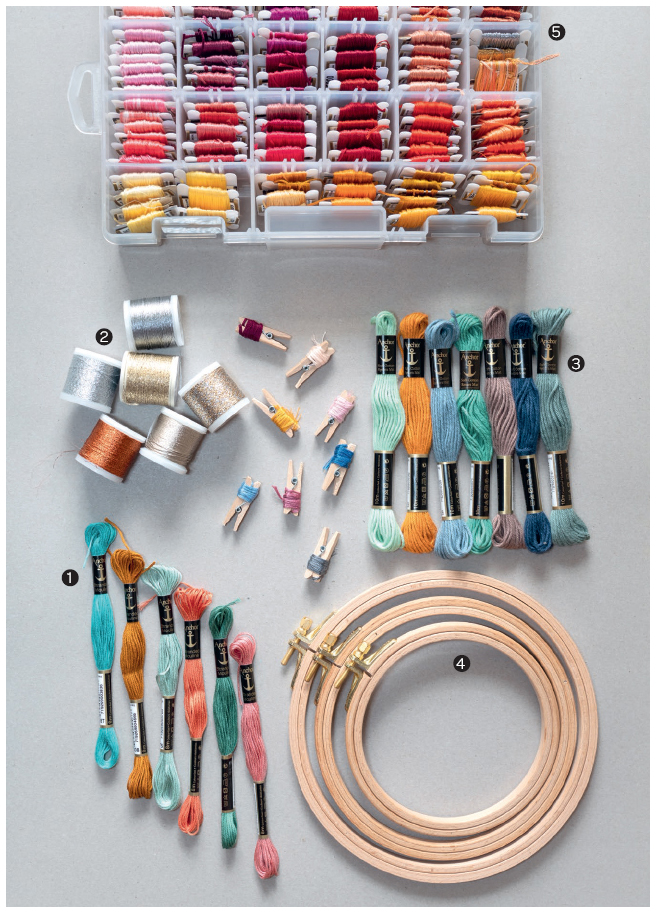
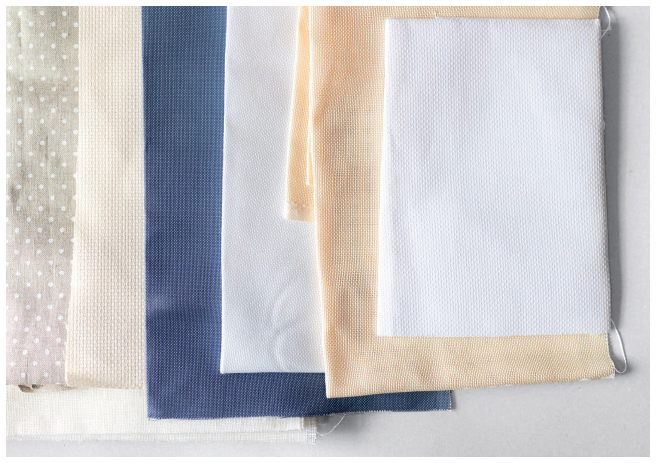 Fabrics There are lots of different embroidery fabrics that vary depending on the project. I only suggest counted fabrics here, as these are needed for cross-stitch. Aida Cloth Made of cotton or linen, this is probably the most well-known counted fabric. Its very popular with beginners, as its really easy to see and count the individual squares. The size of the fabric is given in stitches per inch; one fabric may have 16 stitches per inch, while another may only have 6 stitches per inch.
Fabrics There are lots of different embroidery fabrics that vary depending on the project. I only suggest counted fabrics here, as these are needed for cross-stitch. Aida Cloth Made of cotton or linen, this is probably the most well-known counted fabric. Its very popular with beginners, as its really easy to see and count the individual squares. The size of the fabric is given in stitches per inch; one fabric may have 16 stitches per inch, while another may only have 6 stitches per inch.
Even though you can embroider the designs from this book on a wide variety of counted fabrics, its important to consider the size of the project. Beginners should keep in mind that the smaller the number of stitches per inch, the easier (but also larger) the project will be. Linen Linen is finer than Aida fabrics, but the squares are not so clearly visible. Its good to use for cross-stitch but isnt recommended for beginners because of its structure. Canvas Canvas is woven with only 2 threads and is easy to embroider with wool or matte embroidery threads. 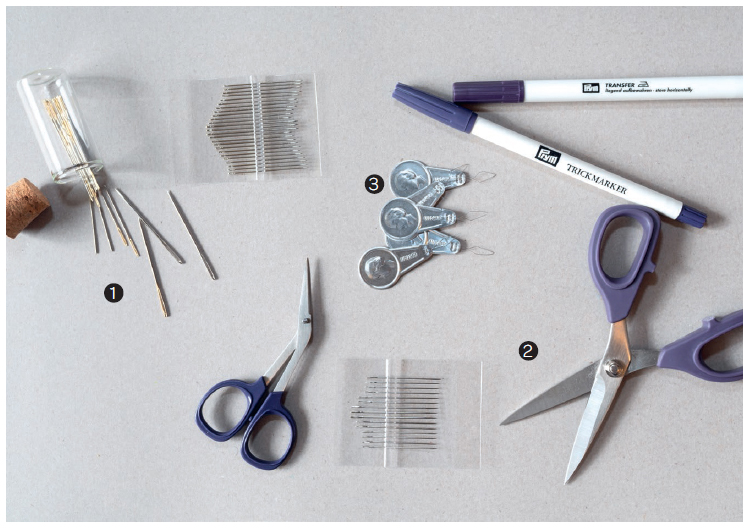 Other Embroidery AccessoriesTapestry Needle (1) For cross-stitch projects, you need a tapestry needle without a point.
Other Embroidery AccessoriesTapestry Needle (1) For cross-stitch projects, you need a tapestry needle without a point.  Other Embroidery AccessoriesTapestry Needle (1) For cross-stitch projects, you need a tapestry needle without a point.
Other Embroidery AccessoriesTapestry Needle (1) For cross-stitch projects, you need a tapestry needle without a point.
The size of the needle depends on the size of the fabric and how many threads you want to use. If you want to try out different options, you can buy needle sets that contain several needle sizes. Scissors (2) Small, pointed scissors and large fabric scissors are required. Threading Aid (3) This tool makes it easier to thread up the needle, especially for beginners. The floss is pulled through the wire loop and can then be threaded more easily into the smaller eye of the needle. 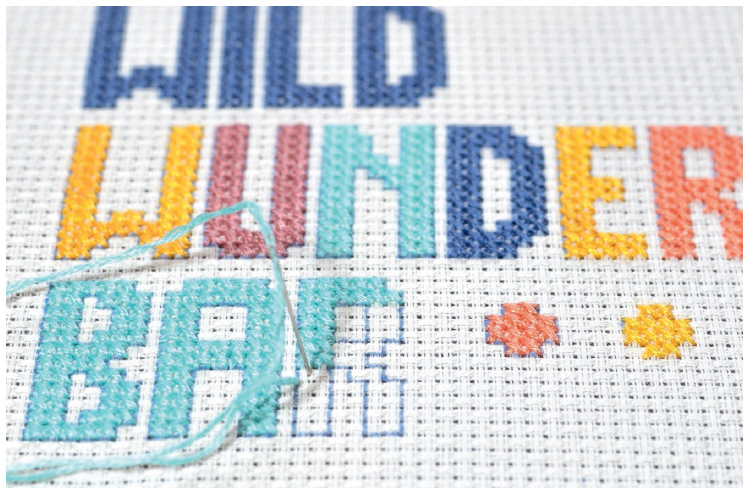 Marker Pens Even though it is unusual, I tend to draw the counting motif onto the fabric before I start.
Marker Pens Even though it is unusual, I tend to draw the counting motif onto the fabric before I start.
It makes the embroidery easier since you no longer have to count, but it is a personal choice and isnt always necessary. There are different markers that disappear when exposed to heat, light, or water. Cross-stitch traditionally involves counting while embroidering without pre-marking, but just see which way you find easier. Other ToolsCardstock I cut the card into shape with the help of the embroidery hoop and glue it to the back of my project if the finished piece is being displayed on the wall in the hoop. Craft or Fabric Glue I use this to glue the back side of the fabric. 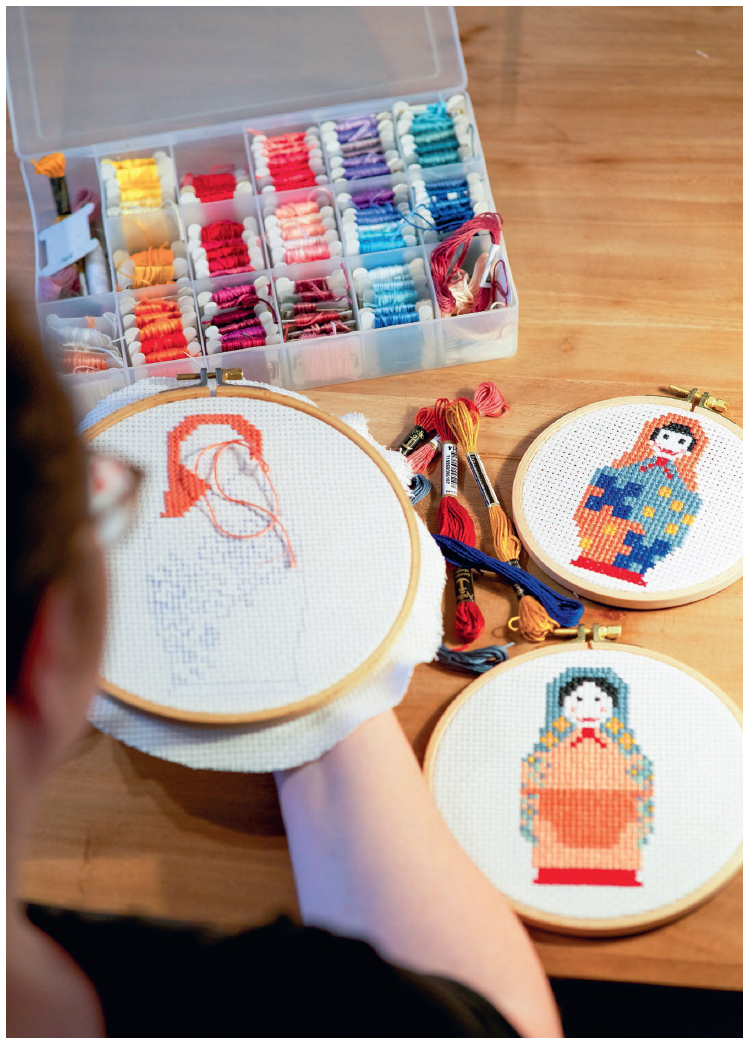

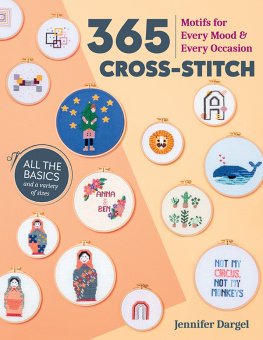

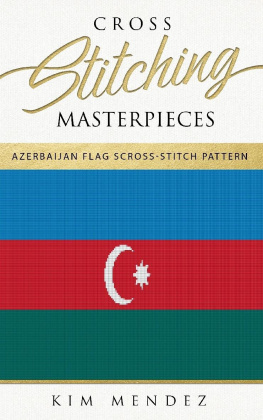
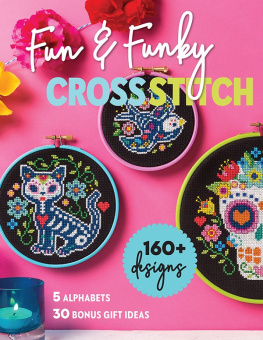

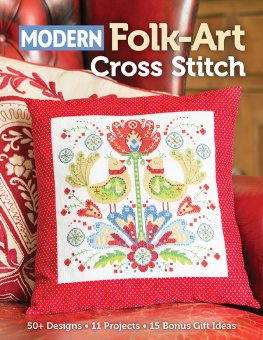
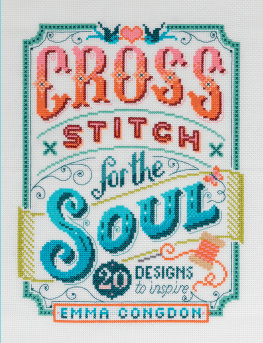
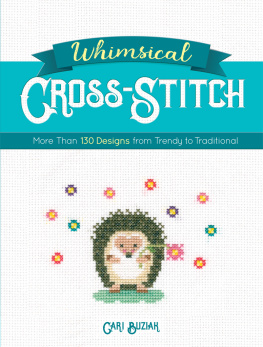
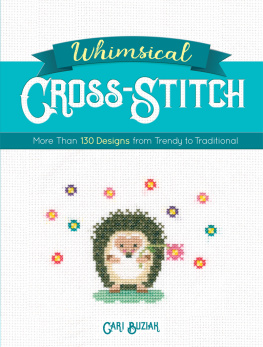
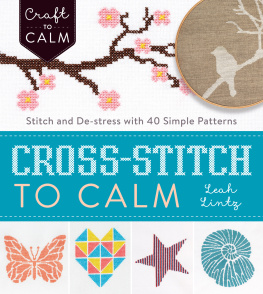
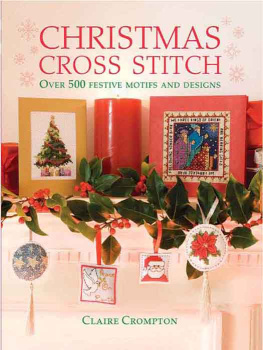
 INTRODUCTION
INTRODUCTION  This book is for anyone who wants to get creative with stitching. Beginners will find valuable tips and instructions on all things embroidery, while those who are more advanced will find a colorful collection of creative and modern ideas that can all be completed with a single embroidery techniquethe cross-stitch. I designed this book to encourage you to use your imagination. The patterns can be mixed together to create unique individual pieces by using the embroidery alphabet to make various sayings and names. In addition, motifs have been designed in the same or similar color families so they can be easily combined. You can always start with one design and then go a step further by adding another motif from this series.
This book is for anyone who wants to get creative with stitching. Beginners will find valuable tips and instructions on all things embroidery, while those who are more advanced will find a colorful collection of creative and modern ideas that can all be completed with a single embroidery techniquethe cross-stitch. I designed this book to encourage you to use your imagination. The patterns can be mixed together to create unique individual pieces by using the embroidery alphabet to make various sayings and names. In addition, motifs have been designed in the same or similar color families so they can be easily combined. You can always start with one design and then go a step further by adding another motif from this series.  from Sonntagskreativitt (Sunday Creativity) THE BASICS
from Sonntagskreativitt (Sunday Creativity) THE BASICS  MATERIALS & EQUIPMENT Embroidery Floss Embroidery floss is available in different varieties and colors. Embroidery Floss (1) Embroidery floss is made up of 6 intertwined threads and is probably the most commonly used of all embroidery floss.
MATERIALS & EQUIPMENT Embroidery Floss Embroidery floss is available in different varieties and colors. Embroidery Floss (1) Embroidery floss is made up of 6 intertwined threads and is probably the most commonly used of all embroidery floss.
 Fabrics There are lots of different embroidery fabrics that vary depending on the project. I only suggest counted fabrics here, as these are needed for cross-stitch. Aida Cloth Made of cotton or linen, this is probably the most well-known counted fabric. Its very popular with beginners, as its really easy to see and count the individual squares. The size of the fabric is given in stitches per inch; one fabric may have 16 stitches per inch, while another may only have 6 stitches per inch.
Fabrics There are lots of different embroidery fabrics that vary depending on the project. I only suggest counted fabrics here, as these are needed for cross-stitch. Aida Cloth Made of cotton or linen, this is probably the most well-known counted fabric. Its very popular with beginners, as its really easy to see and count the individual squares. The size of the fabric is given in stitches per inch; one fabric may have 16 stitches per inch, while another may only have 6 stitches per inch. Other Embroidery AccessoriesTapestry Needle (1) For cross-stitch projects, you need a tapestry needle without a point.
Other Embroidery AccessoriesTapestry Needle (1) For cross-stitch projects, you need a tapestry needle without a point.  Marker Pens Even though it is unusual, I tend to draw the counting motif onto the fabric before I start.
Marker Pens Even though it is unusual, I tend to draw the counting motif onto the fabric before I start.